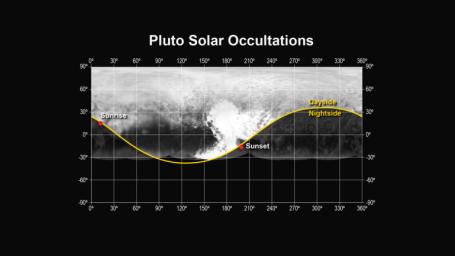
|
Pluto Solar Occultations
- Click the image above for a larger view
- Full-Res JPEG (1280 x 720) (66.5 kB)
- Full-Res TIFF (1280 x 720) (2.8 MB)
Caption:
This figure shows the locations of the sunset and sunrise solar occultations observed by the Alice instrument on the New Horizons spacecraft. The sunset occultation occurred just south of the "heart" region of Pluto, from a range of 30,120 miles (48,200 km), while the sunrise occurred just north of the "whale tail", from a range of 35,650 miles (57,000 km).
Background Info:
The Johns Hopkins University Applied Physics Laboratory in Laurel, Maryland, designed, built, and operates the New Horizons spacecraft, and manages the mission for NASA's Science Mission Directorate. The Southwest Research Institute, based in San Antonio, leads the science team, payload operations and encounter science planning. New Horizons is part of the New Frontiers Program managed by NASA's Marshall Space Flight Center in Huntsville, Alabama.
Cataloging Keywords:
| Name | Value | Additional Values |
|---|---|---|
| Target | Pluto | |
| System | Pluto | Kuiper Belt |
| Target Type | Dwarf Planet | KBO |
| Mission | New Horizons | |
| Instrument Host | New Horizons | Cassini Orbiter |
| Host Type | Flyby Spacecraft | |
| Instrument | Alice Ultravilet Spectrometer | |
| Detector | ||
| Extra Keywords | Color, Occultation | |
| Acquisition Date | ||
| Release Date | 2015-07-17 | |
| Date in Caption | ||
| Image Credit | NASA/Johns Hopkins University Applied Physics Laboratory/Southwest Research Institute | |
| Source | photojournal.jpl.nasa.gov/catalog/PIA19715 | |
| Identifier | PIA19715 | |
